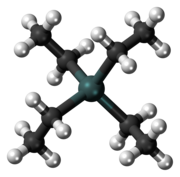
Back Tetraëtiellood Afrikaans رباعي إيثيل الرصاص Arabic تترااتیل قورغوشون AZB Tetraetil olovo BS Tetraetilplom Catalan Tetraethylolovo Czech Tetraetylbly Danish Tetraethylblei German Tetraetilo de plomo Spanish Tetraetüülplii Estonian

| |

| |
| Names | |
|---|---|
| Preferred IUPAC name
Tetraethylplumbane | |
| Other names
Lead tetraethyl
Tetraethyl lead | |
| Identifiers | |
3D model (JSmol)
|
|
| Abbreviations | TEL |
| 3903146 | |
| ChEBI | |
| ChemSpider | |
| ECHA InfoCard | 100.000.979 |
| EC Number |
|
| 68951 | |
| MeSH | Tetraethyl+lead |
PubChem CID
|
|
| RTECS number |
|
| UNII | |
| UN number | 1649 |
CompTox Dashboard (EPA)
|
|
| |
| |
| Properties | |
| C8H20Pb | |
| Molar mass | 323.4 g·mol−1 |
| Appearance | Colorless liquid |
| Odor | pleasant, sweet[1] |
| Density | 1.653 g cm−3 |
| Melting point | −136 °C (−213 °F; 137 K) |
| Boiling point | 84 to 85 °C (183 to 185 °F; 357 to 358 K) 15 mmHg |
| 200 parts per billion (ppb) (20 °C)[1] | |
| Vapor pressure | 0.2 mmHg (20 °C)[1] |
Refractive index (nD)
|
1.5198 |
| Structure | |
| Tetrahedral | |
| 0 D | |
| Hazards | |
| Occupational safety and health (OHS/OSH): | |
Main hazards
|
Flammable, extremely toxic |
| GHS labelling: | |
  
| |
| H300+H310+H330, H360, H373, H410 | |
| P201, P202, P260, P262, P264, P270, P271, P273, P280, P281, P284, P301+P310, P302+P350, P304+P340, P308+P313, P310, P314, P320, P321, P322, P330, P361, P363, P391, P403+P233, P405, P501 | |
| NFPA 704 (fire diamond) | |
| Flash point | 73 °C (163 °F; 346 K) |
| Explosive limits | 1.8%–?[1] |
| Lethal dose or concentration (LD, LC): | |
LD50 (median dose)
|
35 mg/kg (rat, oral) 17 mg/kg (rat, oral) 12.3 mg/kg (rat, oral)[2] |
LDLo (lowest published)
|
30 mg/kg (rabbit, oral) 24 mg/kg (rat, oral)[2] |
LC50 (median concentration)
|
850 mg/m3 (rat, 1 hr)[2] |
LCLo (lowest published)
|
650 mg/m3 (mouse, 7 hr)[2] |
| NIOSH (US health exposure limits): | |
PEL (Permissible)
|
TWA 0.075 mg/m3 [skin][1] |
REL (Recommended)
|
TWA 0.075 mg/m3 [skin][1] |
IDLH (Immediate danger)
|
40 mg/m3 (as Pb)[1] |
| Related compounds | |
Related compounds
|
|
Except where otherwise noted, data are given for materials in their standard state (at 25 °C [77 °F], 100 kPa).
| |
Tetraethyllead (commonly styled tetraethyl lead), abbreviated TEL, is an organolead compound with the formula Pb(C2H5)4. It was widely used as a fuel additive for much of the 20th century, first being mixed with gasoline beginning in the 1920s. This "leaded gasoline" had an increased octane rating that allowed engine compression to be raised substantially and in turn increased vehicle performance and fuel economy.[3][4] TEL was first synthesised by German chemist Carl Jacob Löwig in 1853. American chemical engineer Thomas Midgley Jr., who was working for the U.S. corporation General Motors, was the first to discover its effectiveness as an antiknock agent in 1921, after spending several years attempting to find an additive that was both highly effective and inexpensive.
In the mid-20th century, scientists discovered TEL caused lead poisoning and was toxic to the human brain, especially in children.[5] The United States and many other countries began phasing out the use of TEL in automotive fuel in the 1970s. By the early 2000s, most countries had completely banned the use of TEL in gasoline. Since 2011, leaded gasoline has been banned in every country. A 2011 study backed by the United Nations estimated that the removal of TEL had resulted in $2.4 trillion in annual benefits, and 1.2 million fewer premature deaths.[6]
Despite being banned from use in automotive fuel, TEL is sometimes still used in certain grades of aviation fuel. Innospec has claimed to be the last firm legally making TEL but, as of 2013[update], TEL was being produced illegally by several companies in China.[7] In July 2021, the sale of leaded gasoline for cars was completely phased out worldwide, prompting the United Nations Environment Programme (UNEP) to declare an "official end" of its use in cars on August 30, 2021.[8]
- ^ a b c d e f g NIOSH Pocket Guide to Chemical Hazards. "#0601". National Institute for Occupational Safety and Health (NIOSH).
- ^ a b c d "Tetraethyl lead". Immediately Dangerous to Life or Health Concentrations (IDLH). National Institute for Occupational Safety and Health (NIOSH).
- ^ "Tetra-Ethyl Lead as an Addition to Petrol". British Medical Journal. 1 (3504): 366–7. 3 March 1928. doi:10.1136/bmj.1.3504.366. PMC 2455205. PMID 20773729.
- ^ "After Lead?", Popular Science (October 1987 ed.), Bonnier Corporation, p. 94, October 1987, archived from the original on 13 July 2024, retrieved 23 August 2020
- ^ "LEAD EXPOSURE IN CHILDHOOD LINKED TO LOWER IQ, LOWER STATUS: Leaded gasoline creates a natural experiment in long-term study". Duke University. 28 March 2017. Archived from the original on 13 July 2024. Retrieved 11 March 2022.
- ^ Cite error: The named reference
:1was invoked but never defined (see the help page). - ^ Chung, Kevin (16 August 2013). TEL for MOGAS manufacture in China (PDF) (Report). Summer Hill, NSW, Australia: The LEAD Group, Inc. Archived (PDF) from the original on 22 March 2018. Retrieved 14 January 2018.
- ^ "It's official: You can't buy leaded gasoline for cars anywhere on Earth". cbc.ca. CBC News. 30 August 2021. Archived from the original on 30 August 2021. Retrieved 30 August 2021.
